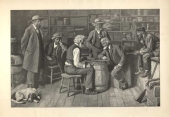The Checker Maven
The World's Most Widely Read Checkers and Draughts Publication
Bob Newell, Editor-in-Chief
Published every Saturday morning in Honolulu, Hawai`i
Noticing missing images? An explanation is here.
Martins' Meatchopper

The antique, hand-operated meat chopper shown in the photo above looks rather wicked, and we'd advise you to keep your all of your fingers well clear when operating this particular instrument. In a somewhat similar manner, you'll need to watch your fingers as you move the pieces in today's installment from Willie Ryan's Tricks Traps & Shots of the Checkerboard. Willie calls it Martins' Meatchopper, and with good reason. Let's let him tell us more.
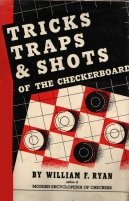
"Perhaps Robert Martins' chief claim to checker fame is premised on the fact that he was the favorite adversary of James Wyllie, and he played the role with ever-modest but tenacious propriety. These venerable old-timers played seven matches, totaling 388 games, with Martins winning one match, losing four, and drawing two. Here is a fine Martins masterpiece on the Bristol, which I learned when I was a boy.
| 11-16 | 27-23 | 9-14 |
| 24-20 | 11-16 | 29-25 |
| 16-19 | 20-11 | 5-9 |
| 23-16 | 7-16 | 22-18---A |
| 12-19 | 25-22 | forming the |
| 22-18 | 4-8 | diagram. |
| 8-11 | 18-15 |
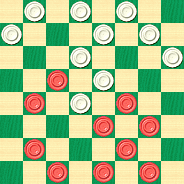
WHITE
Black to Play and Win
B:W32,31,30,28,26,25,23,21,18,15:B19,16,14,10,9,8,6,3,2,1.
A---Loses, and leads to the stroke that follows. White can draw easily with: 31-27, 9-13, 22-18, 1-5, 18-9, 5-14, 27-24, 16-20, 23-16, 20-27, 32-23, 10-19, 16-12 (if 25-22 is played, the draw is attained with 8-12), 2-7, 23-16, 8-11, 25-22, 11-20, 26-23, 6-10, 22-18, 14-17, etc."
Can you operate the meat chopper without slicing your fingers in the process? Work it all out and then chop your mouse on the Read More button to see the solution.![]()
Professor, What's Your Opinion On This?

The position shown just below arose in a game nearly 80 years ago between a certain Phildelphian named Simon Becker, and Professor Guy H. Garwood of McComb, Ohio. Now, McComb is and always has been a small village (its current population is under 2,000) and it has never had a college or university. Perhaps Prof. Garwood taught at nearby University of Findlay, a large and historical school in Findlay, Ohio; but we were unable, in the time we had available, to find out anything about the good Professor except that he was a championship-caliber player who scored some notable wins in big-time tournament play. (The photo above is obviously not of Professor Garwood.)
How, then, did he get himself into the predicament the White forces appear to suffer from? We don't know that answer, either, but we would like to at least metaphorically ask the Professor for his opinion on the position. Professor, it's your move with White, what result?
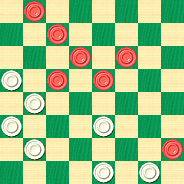
WHITE
White to Play, What Result?
W:W32,31,25,23,21,17,13:B28,15,14,11,10,6,1.
Yet another thing we don't know is if you, our reader, happen to be a Professor yourself. But that's really immaterial. In fact, if you solve this problem correctly, we'll give you the title of Honorary Professor of Checkers. With an incentive like that, we know you'll want to solve it, so do so, and click on Read More to verify your solution.![]()
The Noble Vine

The noble vine and its delicious fruits! The sweet, ripe grapes are in their own right a delightful treat; and the wine that might be made from them can reach loftly heights of pleasure for the palate.
But don't indulge quite yet, for after all, we have our monthly Checker School session to attend first. It, too, is a product of the noble vine; or more precisely, turn of the century checkerists T. Noble and R. Vine. Today they bring us a pair of positions that look similar but in fact are as different as white wine and red wine.
| T. NOBLE | R. VINE |
| WHITE | WHITE |
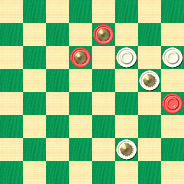 | 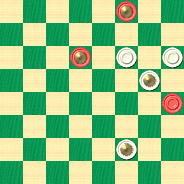 |
| BLACK | BLACK |
| Black to Play and Draw | White to Play and Win |
| B:W22,21,K17,K6:BK26,K23,13. | W:W22,21,K17,K6:BK30,K23,13. |
Black is a man down in both positions, yet he seems to have an advantage in mobility in both cases also. What's the difference? How can he manage to pull out a draw in the first one, but not in the second?
That's what's standing between you and (at least possibly) some sophisticated refreshments at the moment. Solve the problems, and then click on Read More to check the fruits of your labor against the published solutions. You'll also see two sample games, complete explanatory notes, and a very interesting "Advice for Beginners" article from a news column of yesteryear.![]()
Checkers in Hawai`i
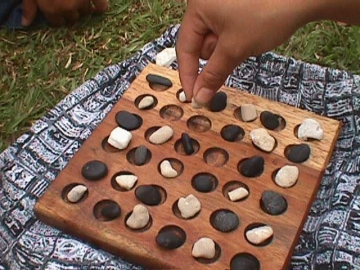
Shown above are the board and pieces for the game Konane, also commonly know as "Hawaiian Checkers" even though the game has nothing at all to do with checkers! Still, it's an excellent game of skill, and has been played in Hawai`i since ancient days.
Seemingly less common in Hawai`i is our own game of checkers; we can't find any history of formal competition and there is certainly no officially recognized state champion. But local checker fan Geoffrey Pang is about to change all that. He's organizing and sponsoring an honest-to-goodness checker tournament in Mililani, on the island of O`ahu, on July 24, 2010, at the Mililani Town Center. The tournament is informal (and not an official American Checker Association event). If you're on O`ahu on the 24th, we encourage you to play. There is no entry fee. Simply contact Geoff at gpang_abm@msn.com to let him know you're coming, and show up at 9:00 AM. The tournament will take place at the beautiful outdoor location shown below. The Checker Maven will be on hand to cover the event, and we'll publish the results in a forthcoming Saturday edition.

Now, for today's column, we really couldn't come up with a Hawaiian-themed checker problem. But after a little thought, we decided that given Hawai`i's storied history of kings, queens, and other royalty, a problem involving many kings might be just the ticket; and fortunately, we were able to locate one. It's diagrammed below, and a festival of kings it surely is.
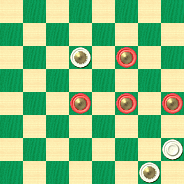
WHITE
White to Play and Win
W:WK10,28,K32:BK11,K18,K19,K20.
This one is really easy enough to have been a fifteen second speed problem, but in Hawai`i, we're hardly ever in a hurry, so take your time, then click on Read More to see the royally simple solution.![]()
4th of July Special
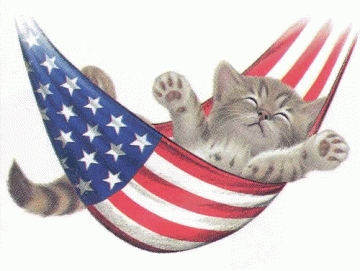
The Fourth of July, American Independence Day, is one of our favorite national holidays, as we've said in these columns many times before. We're unabashed patriots, happy and proud to celebrate the anniversary of America's birth each and every year.
The Checker Maven, when marking a special occasion, invariably turns to the dean of American problemists, Tom Wiswell. In keeping with that tradition, we present a problem that Mr. Wiswell says is one of his earliest, taken from actual play. He calls it practical and pleasing; we call it spectacular, providing a display of checkeristic fireworks to go along with the aerial fireworks traditional on the Fourth of July.
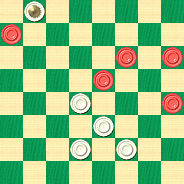
WHITE
White to Play and Draw
W:W27,26,23,18,K1:B20,15,12,11,5.
Black is going to press the White man on 27, at the very least. How can White save the day? Take this one along with you to the Fourth of July picnic, and solve it with your checker friends; then be sure to click on Read More to check your solution. Enjoy the fireworks, both on and off the board!![]()
Basic Checkers, 2010 Edition
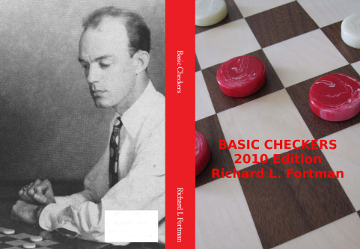
We're giving over much of this week's column to unabashed advertising, but when you read the rest, you'll surely support our efforts, and will be confident we haven't abandoned our non-commercial policies.
For years, Richard Fortman's Basic Checkers has been the veritable bible for 3-move checker players. Certainly, new works such as Solid Checkers, The Golden Dozen, and others, have come on the scene to correct, supplement, and expand upon Mr. Fortman's original work, going beyond the 137 opening ballots in use 30 years ago. But every serious checkerist is likely to have studied Basic Checkers at some point, and may even have a copy of the original seven self-published, typewritten, spiral-bound booklets.
The Checker Maven is proud to announce that a newly typeset, professionally bound and printed edition of Basic Checkers is now available. Your editor, in conjunction with Jim Loy, John Acker, and artist Louisa Gilani have combined forces to produce this new 2010 edition, with all seven volumes in one 6x9, 504 page trade paperback, which is being sold at a price that nearly anyone can afford. Completely reformatted and set in clear, readable type, it is our hope that this work, which is now hard to find and expensive even if found, will once again be placed in the hands of checker players everywhere.
100% of net income will go to the American Checker Federation Youth Fund in honor of Mr. Fortman.
The book will be sold at the Nationals this August for just $25.00. If you can't be at the Nationals, you can get a copy online through CreateSpace. Additionally, the book will be available in a few weeks directly from Amazon or by special order in bookstores, for $30.00 plus shipping.
And now, let's look at a problem position taken from the book. It stems from the 9-13, 24-19, 6-9 opening.
Game: 9-13, 24-19, 6-9, 22-18, 11-15, 18-11, 8-24, 28-19, 4-8, 25-22,8-11, 22-18, 9-14, 18-9, 5-14, 29-25, 11-15---A, 19-16, 12-19, 23-16, 1-6---B, 27-23, 7-11,16-7, 2-11, 25-22, 3-8, 32-27---C, 8-12,27-24, 11-16, 24-20, 16-19, 23-16, 12-19,22-17, 13-22, 26-17, 14-18, 20-16, 18-23,16-11, *6-9, 17-13, 9-14, 11-8, 23-27, 31-24, 19-28, 8-3, 15-19, 3-7, 10-15, 7-11,14-18, 30-26---D.
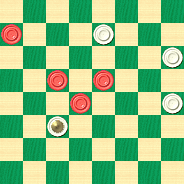
BLACK
Black to Play and Draw
B:W26,21,13,K11:B28,19,18,15.
Notes A to D below are excerpted from Basic Checkers with minor editing.
A---Instead of 1-6.
B---Instead of 1-6, Freyer v. Zuber in the 1981 Florida Open played 14-18, into Banks-Hellman, 2nd National Checkers Association Tournament.
C---Here 31-27 is usual, then 8-12, 27-24, 11-16, 24-19, 15-24, 23-19, 16-23, 26-19, 13-17, 22-13, 14-18, 30-26, etc., drawn. Credited to Denvir and Bradford. The text would seem to be a fine vary, used by the late Colorado master on mail play.
D---Forms a fine problem to arise in play--- Black to move and draw.
Basic Checkers, despite the title, is a rather advanced work, but the problem above isn't as difficult as you might think. Solve it and then click on Read More for the snappy solution ... and then order your copy of the book!![]()
Willie's Windmill

Willie's title for this entry in his fabled Tricks Traps & Shots of the Checkerboard is appropriately named, for at least two reasons. One is that the solution to Willie's position resembles, in an imaginative way, the action of a windmill as represented on a checkerboard. The other reason is that Willie seems to have been tilting at windmills a bit, and makes a most atypical misjudgment of the final outcome. Let's have a look and a listen as Willie sets forth his premise.

"This time we have a combination in-and-out shot of the type most frequently missed in actual play. The experts seldom 'muff' a straight or ordinary in-and-outer, but there are many kinds of in-and-outs, and the more complex varieties are often overlooked, even by top-flight champions.
| 11-16 | 19-16---1 | 2-7 |
| 22-18 | 12-19 | 22-18 |
| 16-20 | 23-16 | 8-11 |
| 25-22 | 5-9 | 32-27 |
| 10-14 | 16-12 | 14-17---A |
| 29-25 | 7-10 | 21-14 |
| 8-11 | 27-23 | 10-17 |
| 18-15 | 10-19 | 23-19 |
| 11-18 | 23-16 | 9-14 |
| 22-15 | 1-5 | 18- 9 |
| 9-13 | 25-22 | 5-14 |
| 24-19 | 6-10---2 | 31-26---B, |
| 4-8 | 26-23 | results in the diagram. |

BLACK
Black to Play and Draw
B:W30,28,27,26,19,16,12:B20,17,14,13,11,7,3.
The original terms of this position were Black to Play and Win---Ed.
A---If black plays 13-17 here, white brings home the draw with this timely stroke: 13-17, 18-15*, 11-18, 12-8*, 3-26, 31-22-15-6, 7-11, 6-2, 11-15, 2-6, 9-13, 6-9, 14-18, 21-14, 15-19, 30-26, 13-17, 9-13, 17-22, 26-17, 19-23. Wm. F. Ryan.
B---Caught and caged! Black now executes a whirlwind shot with a double-action in-and-outer. Of course, 30-26, 17-21, 26-22*, 21-25,19-15, 11-18, 22-15, 14-18, 15-11, 7-10,12-8, 3-19, 27-24, will corral a draw easily. Wm. F. Ryan."
1---28-24 might be better here as Black now gets a small advantage---Ed.
2---14-17 would have held Black's small edge---Ed.
Can you find the combination shot that draws (not wins) for Black, or will you tilt at windmills yourself? Work it out and spin your mouse to Read More to see the solution and a bit more analysis.![]()
Believe It Or Don't

You probably recognize the device shown above; it's called a Tesla Coil. It delivers a very high voltage but an extremely low current and so is a relatively safe gadget, and was used back in the day to do all sorts of "shocking" and "unbelievable" tricks such as making a woman's hair stand up and other stunts of a similar ilk. Of course, shining the light of scientific explanation on these parlor tricks demonstrated clearly how it was done and provided a modicum of education as well as amusement.
So, we weren't sure whether to call this column "Shocking" instead of "Believe It Or Don't" because today's problem contains an element of both sharp surprise and incredulity; and it's entertaining as well as didactic. Let's go straight to the diagram.
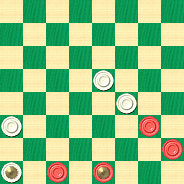
BLACK
Black to Play and Win
B:W18,14,12,K4:B9,5,3,K2.
Although you may not believe it at first glance, Black has an easy win in this position! As with many such "unbelievable" things, a little deeper look usually reveals the truth of the matter. Still and all, Black seems to be in as much of a jam as White; how can he pull off what might be seen as a rather shocking quick win? As they say, believe it and make it so.
When you've come up with your answer, click on Read More for the electrifying and completely believable solution.![]()
Croon in June

Croon, June, spoon, moon ... these were the rhymes used in many a song during the days of what was known in the music business as "Tin Pan Alley," which had its reign during much of the same era that the game of checkers had its own, from the late 1800s through perhaps the 1930s. Though the songs of Tin Pan Alley might seem trite and shopworn to a modern audience, in their own day they were, as they say, "The Cat's Meow."
You certainly aren't reading our column, though, because you think checkers is shopworn or trite; we're certainly of the opinion that it remains as fresh and interesting as ever a game could be. So, to help you croon at the start of June, we've brought you an especially pleasing speed problem. Bit we won't give you the typical three or so minutes that a Tin Pan Alley song would last; you've got only 20 seconds--- maybe just enough time for a quick chorus.
When you're ready to croon, click on the link below to display the problem and start the clock ticking. When you're done, come back and click on Read More and we'll sing out the solution.
June Speed Problem (20 second time limit; fairly easy)
![]()
Perpetual Motion
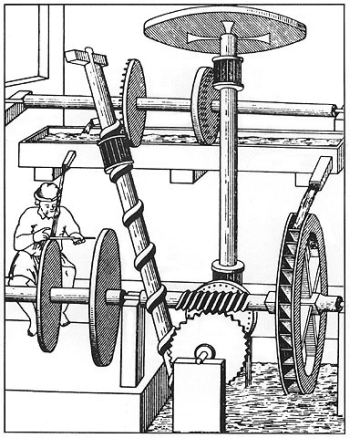
Perpetual motion, like alchemy, was a dream of scientists of a bygone era. Not equipped with the knowledge and tools of later days, they hoped to build a machine that was self-sustaining and would operate forever. Alas, such a thing is not possible; reaching 100% efficiency in the practical world simply doesn't happen, and, lacking energy input of some type, everything runs down in the end. As with the search for a way to turn base materials into gold, the quest for perpetual motion was never to succeed. Still, much time, effort, and ingenuity was expended designing devices such as the one shown above.
Perpetual motion of a different kind, however, can be found in the game of checkers. While we're not going to give away any more than that, you'll understand our meaning when you've worked through today's problem, which is diagrammed below.
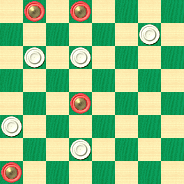
WHITE
White to Play and Draw
W:W8,9,10,21,26:BK1,K2,K18,K29.
White has five men against four kings; his extra piece is going to go fast and then four men have to face four kings. It seems hopeless, but there is a brilliant way to draw which demonstrates once again the incredible possibilities present on the checkerboard.
Don't just go through the motions; perpetuate your efforts and find the solution! And as you know, clicking on Read More is our perpetually-valid means of moving to the solution.![]()
The Checker Maven is produced at editorial offices in Honolulu, Hawai`i, as a completely non-commercial public service from which no profit is obtained or sought. Original material is Copyright © 2004-2025 Avi Gobbler Publishing. Other material is public domain, as attributed, or licensed under Creative Commons. Information presented on this site is offered as-is, at no cost, and bears no express or implied warranty as to accuracy or usability. You agree that you use such information entirely at your own risk. No liabilities of any kind under any legal theory whatsoever are accepted. The Checker Maven is dedicated to the memory of Mr. Bob Newell, Sr.

